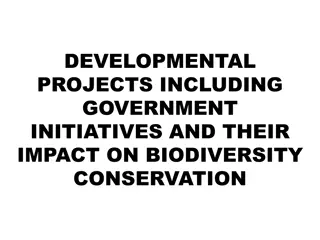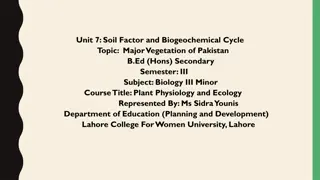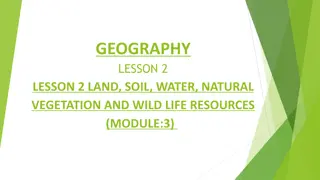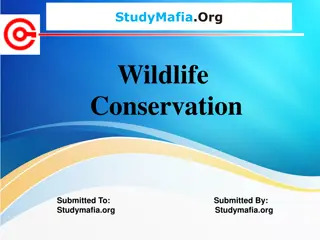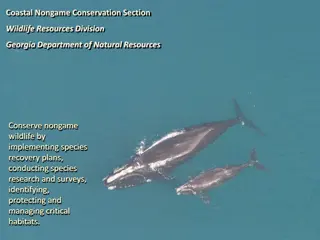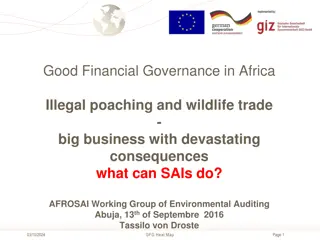
Natural Vegetation and Wildlife Diversity in India
Explore the beauty of natural vegetation and wildlife in India, from tropical rainforests to desert flora. Learn about different types of natural vegetation, their locations, and the importance of wildlife conservation efforts. Discover the rich biodiversity that thrives in various regions of the country.
Uploaded on | 1 Views
Download Presentation

Please find below an Image/Link to download the presentation.
The content on the website is provided AS IS for your information and personal use only. It may not be sold, licensed, or shared on other websites without obtaining consent from the author. If you encounter any issues during the download, it is possible that the publisher has removed the file from their server.
You are allowed to download the files provided on this website for personal or commercial use, subject to the condition that they are used lawfully. All files are the property of their respective owners.
The content on the website is provided AS IS for your information and personal use only. It may not be sold, licensed, or shared on other websites without obtaining consent from the author.
E N D
Presentation Transcript
StudyMafia.Org Natural Vegetation Submitted To: Submitted By: Studymafia.org Studymafia.org
Table Contents What is Natural Vegetation? Types of Natural Vegetation Natural Vegetation Propagation What is Wildlife? Examples of Wildlife Conservation of Wildlife Conclusion 2
What is Natural Vegetation? A plant population that has evolved naturally without the assistance of humans is referred to as natural vegetation. This is what we refer to as virgin vegetation. Cultivated fruits and crops, as well as orchards, are considered vegetation, but not natural vegetation. Plants from a specific area or time period are referred to as flora. The word "fauna" refers to animal species. 3
Types of Natural Vegetation Tropical Evergreen Rain Forests: Tropical Evergreen Rainforests are located in areas with even more than 200 cm of annual precipitation. They are mostly located in the northeastern states of Assam, Meghalaya, the Western Ghats, Nagaland, the Himalayan Tarai zones, the Andaman Islands and Arunachal Pradesh. They can also be found in the Khasi and Jaintia hills. The trees throughout this area are gaining a lot of height. 5
Types of Natural Vegetation Deciduous or Monsoon Type of Forests: On the lower elevations of the Himalayas, Chhattisgarh, West Bengal, Bihar, Orissa, Karnataka, Maharashtra, Jharkhand, and the surrounding areas, deciduous forests can be found. The rainfall in this region ranges from 100 to 200 cm. Teak is the most common tree in the region. Deodar, Pal Ash, Blue Gum, Sandalwood, Sal, Ebony, Arjun, Khair, and Bamboo are among the other trees. 6
Types of Natural Vegetation Dry Deciduous Forests and Scrubs: Such forests thrive in climates with annual precipitation ranging from 50 to 100 centimeters. The Central Deccan plateau, Haryana, Punjab, portions of Uttar Pradesh, Madhya Pradesh, and the southeast of Rajasthan are the most affected. 7
Types of Natural Vegetation Semi Desert and Desert Vegetation: The annual rainfall in this region is less than 50 cm. This vegetation zone is home to thorny trees, acacia, and Babul. The Indian wild date is commonly found in this region. They have dense flesh and broad roots. Plants in this area hold water in their stems to help them survive the drought. Gujarat, Punjab, and Rajasthan all have this kind of vegetation. 8
Types of Natural Vegetation Tidal or Mangrove Forests: Rainfall totals only about 50 cm in this region. This vegetation zone is home to thorny acacia, bushes, and Babul trees. Here is where you'll find the Indian wild date. Large roots and dense flesh are characteristics of this species. This region's plants store water in their stems to withstand the drought. Gujarat, Punjab, and Rajasthan all have areas with this kind of vegetation. In such forests, the Sundari' is perhaps the most important tree. 9
Natural Vegetation Propagation When an axillary bud develops into a lateral shoot that has its own roots, this is considered as biological vegetative propagation (also termed as adventitious roots). Since specialized organs of vegetative reproduction, such as seeds in annuals, help to withstand seasonally harsh environments, some species of plants that withstand and substantially grow through vegetative reproduction are almost by definition perennial. 10
Natural Vegetation Propagation A clonal community is a plant that survives in a given location by the vegetative reproduction of organisms over a prolonged period of time.In certain ways, Natural vegetative propagation is a method of survival and growth of the individual's biomass rather than reproduction. The process of "vegetative development" occurs when an individual organism grows in size through cell multiplication while remaining intact. 11
What is Wildlife? Wildlife used to belong to undomesticated animal species, but it has since expanded to include those animals that evolve or live in the wild without being established by humans. In all habitats, wildlife can be identified. Deserts, grasslands, wetlands, deserts, rainforests, and other regions, including the world's most populated cities, all have unique wildlife. 12
Examples of Wildlife Gir National Park and Wildlife Sanctuary, also known as Sasan Gir in Gujarat is home to Asiatic lions. India is also home to the most magnificent mammal on the planet: the elephant. Tigers are generally found in the Himalayan region, in the forests of Madhya Pradesh, and in the Sundarbans of West Bengal. 14
Examples of Wildlife The leopard is one of the most important animals of prey. The wetlands and forests are home to peacocks, pheasants, ducks, parakeets, cranes, and pigeons. The one-horned rhinoceroses live in the swampy and marshy areas of Assam and West Bengal. 15
Examples of Wildlife The Tibetan antelope, The yak, the shaggy horned wild ox weighing around one ton, wild sheep, the bharal (blue sheep), and the kiang (Tibetan wild ass) are found in the freezing high altitudes of Ladakh. Camels and wild asses are found in arid areas of the Thar Desert, and the Rann of Kachchh, respectively. 16
Conservation of Wildlife Forests provide us with oxygen and precipitation. Soil erosion is prevented by forests. Pollination and seed dispersal are both based on animals and birds for plants. Forests supply us with a variety of medicines.In industries, a variety of forest products are being used as raw resources. 17
Conservation of Wildlife They are a constant in the natural world. These wildlife communities help to preserve ecological balance. Some animals are extinct, and others are on the verge of becoming extinct. Endangered animals ought to be safeguarded. Wildlife has the same right to exist on this planet as humans. 18
Conclusion India also has approximately 90,000 species of animals, as well as, a rich variety of fish in its fresh and marine waters. Natural vegetation refers to a plant community, which has grown naturally without human aid and has been left undisturbed by humans for a long time. This is termed as a virgin vegetation. 19
Thanks To StudyMafia.org



